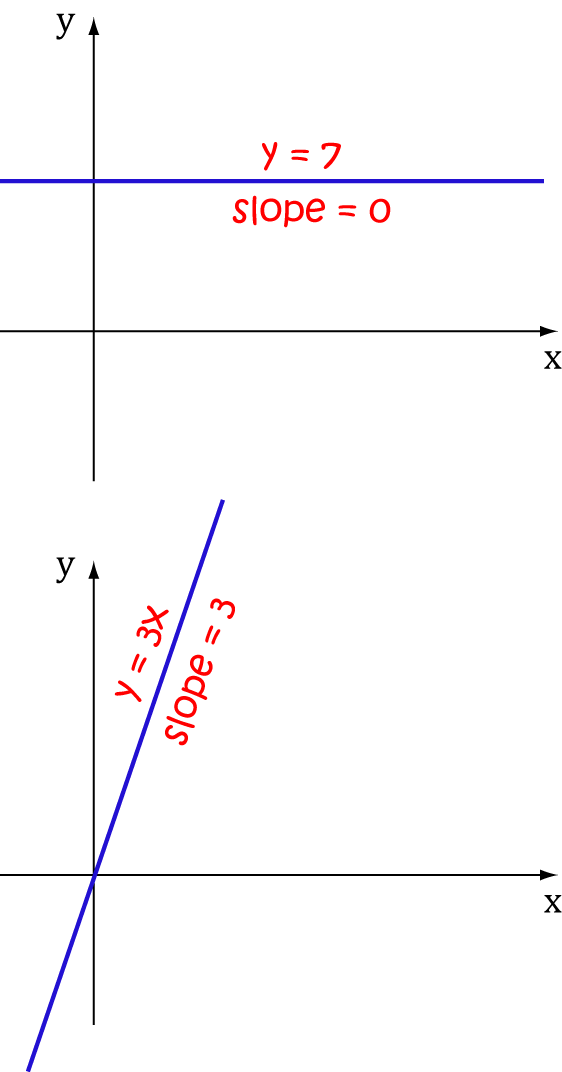Calculus
Chapters
Rules of Differentiation
Rules of Differentiation
Differentiation has many useful applications. For example, you might need to know the rate of bacterial growth on that pair of sweaty socks you left at the bottom of your sports bag, or Gus the snail's instantaneous speed in his latest attempt at the land-speed record. There are other more standard applications, like finding the slope of a graph at a particular point, or the maximum and minimum values of a demand function. Fortunately, we don't always need to pull out the limits to calculate these things. Instead, we can apply the rules of differentiation. The purpose of this article is to give you a summary of these rules, and a few examples of their application. Other articles will discuss the power rule, chain rule, product rule and quotient rule in more depth.
Let's start with a couple of examples. Don't forget that the little prime mark ' means "the derivative of".
- The slope of a horizontal line like \(y = 7\) is always zero.
- Of course the slope of a vertical line is undefined.
- The slope of a line like \(y = 3x\) is \(3\). The slope of the line \(y = mx + b\) is \(m\).

Derivatives of Commonly Occurring Functions
So that you don't have to continually pull out the limits to find the derivatives of commonly occurring functions, let's write a list of their derivatives that you can refer back to whenever you feel the need.
| Function description | Function expression | Derivative |
| Constant Function (\(k\) is for 'konstant') | \(\displaystyle{ k }\) | \(0\) |
| Straight Line | \(\displaystyle{ x }\) | \(1\) |
| \(kx\) | \(k\) | |
| \(mx + b\) | \(m\) | |
| Square | \(\displaystyle{x^2}\) | \( 2x\) |
| Square Root | \(\sqrt{x} = x^{\frac{1}{2}}\) | \( \dfrac{1}{2}x^{-\frac{1}{2}} = \dfrac{1}{2 \sqrt{x}}\) |
| Exponentials | \(a^x\) | \( a^x \ln (a)\) |
| \(e^x\) | \(e^x \ln (e) = e^x\) | |
| Logarithms | \(\ln(x)\) | \( \dfrac{1}{x}\) |
| \(\log_b(x)\) | \( \dfrac{1}{x \ln(b)}\) | |
| Trig functions (don't forget \(x\) is measured in radians!) | \( \sin x \) | \(\cos x\) |
| \(\cos x \) | \(-\sin x \) | |
| \(\tan x\) | \(\sec^2 x\) | |
| Inverse Trig Functions (don't forget the restrictions on the domain) | \( \sin^{-1}(x) \) | \(\dfrac{1}{\sqrt{1 - x^2}}\) |
| \( \cos^{-1}(x) \) | \(-\dfrac{1}{\sqrt{1 - x^2}}\) | |
| \(\tan^{1} (x)\) | \(\dfrac{1}{1 + x^2}\) |
Rules of Differentiation
And now for the rules that help you stitch the above derivatives together to come up with the derivatives of some really impressive-looking functions. Differentiation is a great party trick!
| Name of Rule | Function expression | Expression for Derivative |
| Multiplication by a constant | \( kf(x)\) | \(k f'(x)\) |
| Power Rule (\(n \neq -1\)) | \(x^n\) | \(nx^{n-1}\) |
| Sum and Difference Rules | \((f + g)(x)\) | \(f'(x) + g'(x)\) |
| Product Rule | \(fg\) | \(fg' + f'g\) |
| Quotient Rule | \(\dfrac{f}{g}\) | \(\dfrac{gf' - fg'}{g^2}\) |
| Chain (or function of a function) Rule using ' notation | \(f(g(x))\) | \(f'(g(x))g'(x)\) |
| Chain Rule using Leibniz notation | \(y = f(u(x))\) | \(\dfrac{dy}{dx} = \dfrac{dy}{du}\cdot \dfrac{du}{dx} \) |
| Chain Rule using function composition notation | \(f \circ g\) | \((f' \circ g) \times g'\) |
| Reciprocal Rule (or just use the chain and power rules) | \(\dfrac{1}{f}\) | \(-\dfrac{f'}{f^2}\) |
Examples of applying the rules
Let's finish by using the rules to find the derivatives of some functions. Don't forget that the table of common derivatives will be a big help here.
Example 1
Find the derivative of \(\displaystyle{\tan (x)}\).
In the table of common derivatives, the derivative of \(\tan (x)\) is listed as \(\sec^2(x)\). So
Example 2: applying the power rule
Find \( \dfrac{d}{dx}(x^4) \).
Use the power rule with \(n = 4\):
Example 3: more on the power rule - negative indices
Find \(\dfrac{d}{dx}\left(\dfrac{1}{x^2}\right)\).
Remember your index laws: \(\dfrac{1}{x^2}= x^{-2}\), so we can use the power rule here.
Example 4:constant multiplication
Find \(\displaystyle{\frac{d}{dx} (17x^4)}\).
Bring the \(17\) out to the front of the derivative:
Example 5: the derivative of a sum (difference) is the sum (difference) of the derivatives
Find \(\displaystyle{\frac{d}{dx}(x^3 + x^2 - x^6)}.\)
The sum and difference rules say
- \(\dfrac{d}{dx}(x^3) = 3x^2\)
- \(\dfrac{d}{dx}(x^2) = 2x\)
- \(\dfrac{d}{dx}(x^6) = 6x^5\)
Example 6: using the product rule
Find \(\displaystyle{\frac{d}{dx} x^2\cos(x)}\).
The product rule says
Example 7: using the quotient rule
Find \(\displaystyle{\frac{d}{dx} \left(\frac{\sin x}{x^2 + x}\right)}\).
The quotient rule says
Example 8: using the chain rule
We'll just use one form of the chain rule for now. We'll explore several different examples of the application of the chain rule in the article on the chain rule.
Find \(\displaystyle{\frac{d}{dx} (\sin(x^3))}\)
The chain rule says
Description
Calculus is the branch of mathematics that deals with the finding and properties of derivatives and integrals of functions, by methods originally based on the summation of infinitesimal differences. The two main types are differential calculus and integral calculus.
Environment
It is considered a good practice to take notes and revise what you learnt and practice it.
Audience
Grade 9+ Students
Learning Objectives
Familiarize yourself with Calculus topics such as Limits, Functions, Differentiability etc
Author: Subject Coach
Added on: 23rd Nov 2017
You must be logged in as Student to ask a Question.
None just yet!